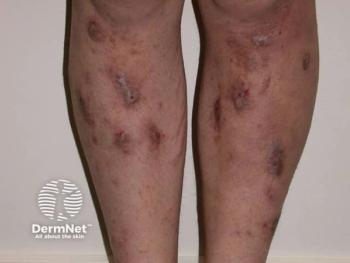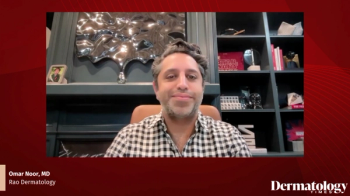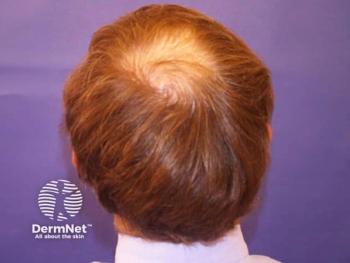
Proteomic Analysis Reveals Potential Differences in Patients Achieving VASI 50 Improvements VS Those Who Do Not
Investigators believe different circulating inflammatory phenotypes in patients with vitiligo may influence their responses to treatment with ruxolitinib cream.
A recent study1 involving proteomic analysis found that baseline levels of circulating inflammatory biomarkers of patients with vitiligo may stratify patients who experienced significant repigmentation after treatment with ruxolitinib cream. Furthermore, these differentially-expressed proteins identified potential differences between patients who achieved a Vitiligo Area and Severity Index (VASI) of 50% or more improvement versus those who did not.
The study, published in the Journal of Investigative Dermatology Innovations, was a post hoc analysis of a phase 2, randomized, double-blinded, and vehicle-controlled study2 (NCT03099304) involving adult patients between the ages of 18 and 75 years old with vitiligo. Patients applied 1.5% ruxolitinib cream once daily (QD) or twice a day (BID).
In the post hoc analysis, investigators classified patients into 1 of 2 groups. Patients in group 1 (n=30) had achieved an F-VASI score of 50 or greater by week 24. Patients in group 2 (n=27) had not achieved the same metric.
"The F-VASI (mean ± standard error) scores of patients in group 1 who applied 1.5% ruxolitinib cream BID improved by 76.9 ± 4.0% and 91.9 ± 1.5% at weeks 24 and 52, respectively. In contrast, F-VASI improved by 1.1 ± 7.3% and 25.1 ± 13.4% among patients in group 2 at weeks 24 and 52, respectively," study authors wrote. "Similarly, T-VASI improved by 37.9 ± 5.9% and 57.6 ± 5.6% at weeks 24 and 52, respectively, in group 1 among patients who applied 1.5% ruxolitinib cream BID, whereas group 2 experienced 8.8 ± 4.7% and 26.8 ± 5.8% improvements at the same time points."
When comparing the percent change in F-VASI scores after treatment with ruxolitinib, investigators noted that patients in group 1 achieved more statistically greater reductions in F-VASI than patients in group 2. At week 52, for example, patients in group 1 achieved a 91.9% F-VASI improvement, while the same improvement was noted in 25.1% of patients in group 2 by the same week.
This significant different in score reduction also translated to T-VASI scores, wherein members of group 1 achieved a 57.6% reduction in T-VASI by week 52, and a 26.8% reduction was observed in patients in group 2.
Further exploring the differences between these 2 patient groups, investigators measured the levels of 1,104 proteins in circulation before treatment with ruxolitinib. A broad proteomic analysis was able to identify approximately 76 differentially-expressed proteins between subgroups 1 and 2 at baseline.
In patients in group 1, specific proteins such as interleukin (IL)-5, IL-20, and IL-13, among 7 others, were upregulated at baseline.
In patients in group 2, specific proteins such as HCLS1, CXCL9, PIK3AP1, CXCL10, and IL-16 were elevated at baseline, among a total of 64 distinct elevated proteins in this group.
Baseline expression of these proteins found that members of group 2 who had not achieved F-VASI50 by week 24 of treatment with ruxolitinib had higher levels of circulating inflammatory markers CCL18, CXCL10, CXCL9, Granzyme B, IL-2R, and MIP3β than those who had achieved F-VASI50.
These differences in circulating inflammatory phenotypes, study authors note, may influence patients' responses to treatment with ruxolitinib cream.
"Combined, these data support the observed therapeutic benefit of JAK1/JAK2 inhibition by ruxolitinib cream in patients with vitiligo and suggest that deeper interrogation of proteomic information could reveal biomarkers capable of stratifying patients at baseline into groups with different patterns of systemic inflammation," wrote Howell et al. "This additional information may be helpful in not only managing vitiligo directly but also the psychosocial impact of the disease on the individual during treatment."
References
- Howell MD, Kuo FI, Rumberger B, et al. Baseline levels of circulating inflammatory biomarkers stratify patients with vitiligo who significantly repigment after treatment with ruxolitinib cream. JID Innov. 2023;3(6):100230. Published 2023 Sep 13.
doi:10.1016/j.xjidi.2023.100230 - Rosmarin D., Pandya A.G., Lebwohl M., Grimes P., Hamzavi I., Gottlieb A.B., et al. Ruxolitinib cream for treatment of vitiligo: a randomised, controlled, phase 2 trial. Lancet. 2020;396:110–120.
Newsletter
Like what you’re reading? Subscribe to Dermatology Times for weekly updates on therapies, innovations, and real-world practice tips.


















